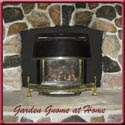I have a serious love/hate relationship with garbage trucks. First and foremost, I don't want to put anything into the garbage truck that could be reused, recycled or anything else. Second, the garbage truck takes away stuff I don't want so out of sight, out of mind BUT the garbage trucks are out to get me. I'm not kidding! Take this morning for example when I am running down the street in my pajamas and slippers with my kitchen catcher sized garbage bag at 6:50 AM. Umm, the town says to have your garbage out to the curb by 7:00 AM so by default I had 10 minutes BUT no they decide to race through our subdivision collecting the garbage 10 minutes early. HOWEVER, if I had put the garbage out the night before they would show up somewhere around noonish. Garbage trucks are seriously out to get me!
I have a real issue about putting out garbage the night before partly due to living in a rural location and really not liking cleaning up any mess from marauding animals so our garbage goes to the curb first thing in the morning. A few years ago, we had someone rummaging through our waste mainly looking for aluminum cans but good gosh, they made more mess than an animal would. I just don't like the idea of garbage sitting out overnight if it can be helped. So on waste collection day, I'm up bright and early to get our small bag of waste and recycle bins out before 7:00 AM. I'm usually taking everything out around 6:45 AM and always before 7:00 AM.
These waste collectors are beyond testy. They won't take anything over 4 bags of trash although you can cheat by putting two bags into a trash bin so technically with two trash bins and 2 bags you can get away with putting out two extra bags. That's not a problem for us because quite frankly, I don't even think the 4 kitchen catcher size bags of garbage we produce in a month would fill a large black garbage bag. These guys have it easy when it comes to us. Seriously, rather than put anything large out to the road, we take it to the waste station ourselves. That include any brush and yard waste. We are gone pretty much 3 months of the year which means they only have to stop for a small garbage bag at most weekly, 9 months of the year but sometimes we just let it accumulate until we have a full large bag so they really only need to stop at our house 9 to 10 times in a year. AND I give them a holiday bonus (card with gift card) PLUS I never complain to the town when they are being testy so you would think they would be just a wee bit nicer to us.
















